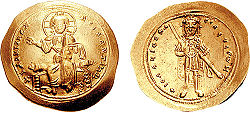Histamenon

Histamenon (
Establishment
Ever since Emperor

Initially, the two coins were virtually indistinguishable except in weight. During the later reign of
Debasement and abolition

Starting with Michael IV, who was a former money lender, the gold content began to be increasingly lowered and the coins debased. After a period of relative stability in c. 1055–1070, the gold content declined dramatically in the disastrous 1070s and 1080s. The michaelata of Michael VII Doukas (r. 1071–1078) still contained some 16 carats of gold, but by the time of Alexios I Komnenos (r. 1081–1118), the nomismata struck contained almost no gold at all.[11][12][13] Thus, in 1092, Alexios I carried out a comprehensive monetary reform, replacing among others the debased gold coins, both the histamenon and the tetarteron, with a new high-quality gold issue, the hyperpyron.[14][15]
Henceforth, and for the duration of the Komnenian monetary system (12th–13th centuries), the term stamenon, due to its association with scyphate coins, came to be applied as a blanket term to the similarly concave billon and copper coins (
References
- ^ Grierson 1999, pp. 3, 9–10.
- ^ ODB, p. 1924.
- ^ a b Hendy 1985, p. 507.
- ^ Grierson 1982, p. 196.
- ^ ODB, pp. 936, 2026.
- ^ Hendy 1985, p. 508.
- ^ Grierson 1999, p. 10.
- ^ ODB, pp. 936, 2026–2027.
- ^ Grierson 1982, p. 197.
- ^ Hendy 1985, p. 510.
- ^ a b Grierson 1999, pp. 10–11.
- ^ Hendy 1985, pp. 509–510.
- ^ ODB, pp. 478, 1368.
- ^ Grierson 1999, p. 11.
- ^ ODB, p. 964.
- ^ Grierson 1999, p. 59.
- ^ ODB, p. 936.
Sources
- Grierson, Philip (1982). Byzantine Coins. London, United Kingdom: Methuen. ISBN 978-0-416-71360-2.
- Grierson, Philip (1999). Byzantine Coinage (PDF). Washington, District of Columbia: Dumbarton Oaks. ISBN 978-0-88402-274-9. Archived from the original(PDF) on 2010-06-13.
- Hendy, Michael F. (1985). Studies in the Byzantine Monetary Economy c. 300–1450. Cambridge, United Kingdom: Cambridge University Press. ISBN 0-521-24715-2.
- ISBN 0-19-504652-8.
